The inaugural Kiwi Brevet run earlier in the year provided the inspiration for a Brevet on the Banks Peninsula, my very own backyard. For the uninitiated, a Brevet is a long distance self-supported cycling event that follows a designated route within a challenging time limit. The winter saw me pouring over online route planners during the evenings and riding sections of the planned course during the weekends. In the end I settled on a course that would take all those that wished, through nearly every road accessible bay on the Peninsula and over its highest point, Mt. Fitzgerald. Le Petit Brevet was born. All up, the course was a smidgen over 300km with a mix of single track, paper, gravel and sealed roads. The real killer was not the distance or rough roads, it was the climbing. My estimate of 5400 m in vertical climbing, which together with a tough 36 hour time limit was daunting. But as d-day loomed another challenge lay in wait, the weather. It deteriorated daily throughout the week so that Friday night saw clouds looming and wet southerlies fast approaching. I wondered whether anyone was going to turn up at all!
The clouds hung low over Hanson Park, the allocated starting point. Slowly people trickled in. In fact, to my surprise, nearly everyone who had signed up turned up – 28 in all. One of the things I like most about the Brevet is the vast array of bike setups on offer. As a Brevet is self-supported, long – often overnight, and visits remote places where food and accommodation can be scarce, carrying the required gear and deciding how to carry it usually sees a Breveter spending a lot of time on gear selection and deciding how to carry it. Although gear envy is pretty much par with any mass gathering of cyclists, in a Brevet, it’s not about the bike, but the attachments that tend to create the most interest. This Brevet was to be no different. The prize this time was easily won by Martin Nichols who had taped 61 muesli bars of various brands to his frame. It had been a hot topic online leading up to the ride but seeing it in the flesh, or should that be the alloy and oats was another thing. It also assured his ageing Marin was the most photographed and discussed bike on display despite the titanium of the Black Sheeps and Lynkseys standing proudly, almost jealously, like stuffed tarts, nearby.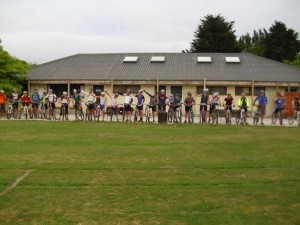
The briefing was short and sweet. This wasn’t a race, it was barely an event, it was merely “a pleasant weekend outing among like minded people”. Responsibility dissolved, an edge of concrete made an affable start line and we lined up for a photo. I checked the official ride clock which was strapped to my wrist, it said 7:58. “Two minutes to go” I announced to the 27 bodies lined up either side of me. I glanced at Simon Kennett alongside who had made the journey down from Wellington to see what Canterbury could throw at him. “What time do you make it?” I asked. “8:02” he replied. Someone else yelled out another time. That’ll do, the line was broken and I led everyone across the freshly mowed Hanson Park to the first climb of the day – Rapaki.
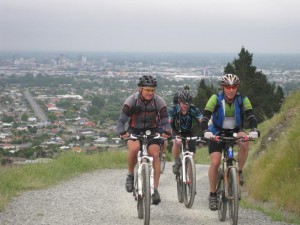 By the top the field was spread far and wide, and the small bunches that still existed then were soon strung out on the Port Hills single track. At 10.3 km the course notes read “Sign of the Kiwi. Stop for a coffee. Sit back and relax, you are 3% of the way…nearly” Jeffrey Collins took me literally and John Randal, another Wellingtonian who had come south to be part of the fun, caught him at it and immortalised the moment in print.
By the top the field was spread far and wide, and the small bunches that still existed then were soon strung out on the Port Hills single track. At 10.3 km the course notes read “Sign of the Kiwi. Stop for a coffee. Sit back and relax, you are 3% of the way…nearly” Jeffrey Collins took me literally and John Randal, another Wellingtonian who had come south to be part of the fun, caught him at it and immortalised the moment in print.
On the first real climb of the day – Port Levy Saddle, I cheated in my own event. At the top, out for ride, was my girlfriend Tina. I stopped for a chat and as I was leaving, Simon and David Drake caught us catching a quick kiss. As this surmounted to outside support, I thought it only fair to offe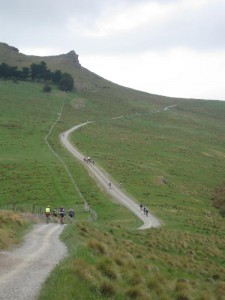 r the same support to all that were to follow. It’s not my problem others thought differently, especially Tina!
r the same support to all that were to follow. It’s not my problem others thought differently, especially Tina!
Approximately 70 km into the ride at the top of the steep Pettigrews Road, we hung a right, crossed a style – the first of 28 according to one Breveter, and headed over farmland across Mt. Fitzgerald to Western Valley Road. It was a pivotal point in the ride and it was the start of the end for at least half a dozen riders. The ridge was hidden in pea-soup and for those that didn’t know the route, and for some of those that did, navigation was a nightmare. Emerging on the other side at the correct spot was rewarded with a quick descent to Little River. Everyone emerged thankfully, but some had been riding in circles for hours and others found themselves not on the pass, but below the pass, on the wrong side. With a solid 200 km plus left, and a course that got no easier, it was the end of the day for some, who pointed their bikes back towards Christchurch and the comfort of home.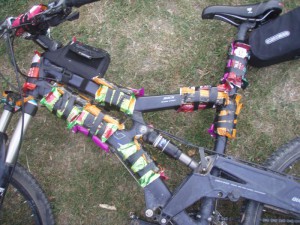
For the rest of us, the reward was soon over. At the bottom, we veered left and within minutes were hauling up the steep gravelled climb of Harmans Track. Harmans Track is a fairly unassuming place but surprisingly its historical context in the New Zealand mountainbiking scene is significant. In April 1985, five competitors lined up for the ‘1st Annual Stock Route Downhill’, New Zealand’s first ever mountain bike race. The competitors plummeted down Harmans Track at over 50 km/hr. I would have liked to have compared times, but going up (instead of down), my speedometer read less then 5km/hr for the climbs entirety, and in protest gave up the ghost and didn’t work again until a week after the ride was over.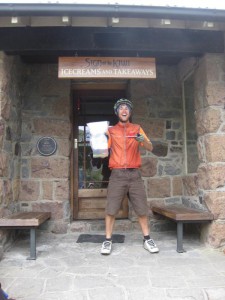
Onto the summit road overlooking the gorgeous Akaroa Harbour, we rolled out the late afternoon miles to Okains Bay. I was joined by Geof Blance, one of two entrants riding single speed. When people had first told me they planned on single speeding the course I honestly thought that they were either joking, mad or had taken up cycling pre 1930’s and had buried their head in the sand ever since. What ever the reason, it didn’t seem to hinder Geof at all. In fact we had ridden together over possibly the toughest 30 km of the course and at times I had struggled to keep pace, maybe I should be the one questioning my choice of stead, get my head out of the sand and join the revolution.
Descending into Okains Bay at 5pm was glorious. We were 9 hours in and with 130km behind us only 40% of the way distance wise. However with over half the climbing done, it was psychologically the half way point. The fish’n’chip shop in Okains Bay can’t often be busy, but as soon as they got wind of what was happening and that dozens of hungry cyclists were likely to turn up late into the night, they took to the task with eagerness, extending their opening hours, filling up water bottles and lining empty stomachs with grease for the evening  that lay ahead.
that lay ahead.
My plan had always been to see how the day went as to whether I would try and ride right through the night or stop somewhere for some shut eye. I had felt terrible most of the morning, but had come right and was eager to push on. Geof had similar ideas so once our fish’n’chips had settled, we left Simon, David and John to the comfort of their hostel beds and set off for Akaroa and the evening that lay ahead.
We were straight into Big Hill Road and after a prolonged climb we plummeted down th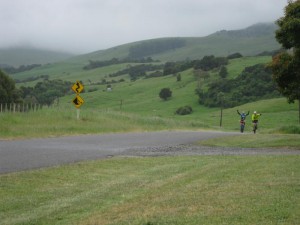 e Peninsulas steepest Road – Panama Road. It was over in a few seconds, a 600 m descent, only to be followed by another long climb out of Le Bons Bay, the story of the entire course really. Alone now, I donned lights and descended to Akaroa via the gnarly and slippery Purple Peak Track. The light drizzle that had fallen all day was showing no sign of stopping so I didn’t stall at Akaroa. Instead I filled up with water, shoved down some food and hit the road once again.
e Peninsulas steepest Road – Panama Road. It was over in a few seconds, a 600 m descent, only to be followed by another long climb out of Le Bons Bay, the story of the entire course really. Alone now, I donned lights and descended to Akaroa via the gnarly and slippery Purple Peak Track. The light drizzle that had fallen all day was showing no sign of stopping so I didn’t stall at Akaroa. Instead I filled up with water, shoved down some food and hit the road once again.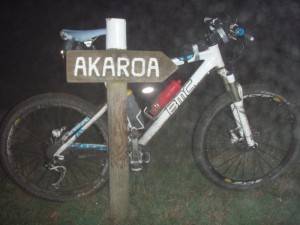
There was just one big climb left after Akaroa. Bossu Road was one of the longest and steepest climbs of the whole ride. Already, my wheels had taken me nearly 6km vertically (my initial estimate of 5400 m total climbing was surpassed by the actual figure – 7500 m) and nearly 200 km in 15 hours. Just to add in an extra challenge for the final big ascent, the false summit and long ridge ride at the top were the most exposed part of the course and the gloomy weather that had threatened us all day choose this time to close in and make things truly miserable. Before I re-entered the realms of the clouds I stopped and glanced across the harbour to the murky rain dulled lights of Akaroa. Above Akaroa I could make out three sets of lights weaving there way down Purple Peak Track. It was 11’o’clock at night. Smiling at the absurdity of it all, I finished off my left over chips (which conveniently were located in my back pocket) and readied myself for a southerly thrashing. Cold chips had never tasted so good.
The steep incline that characterises the first half of Bossu Road finishes at a ridge that affords views as far south as Timaru and in a long arc, the Southern Alps to the west. I know this because I have been there in the day, in the sun and I have marvelled at it. The view is nearly as breathtaking as the climb. But close to midnight with a howling southerly firing rain straight into my already saturated body, sightseeing was not high on the list of priorities. One hour later, soaked and shivering I arrived at Little River. Two bikes sat dejected and forgotten outside the public toilets. Inside I found Michi Speck and Lance Griffin; Lance in a survival blanket, looking pale, and Michi in his wet clothes. With the backdrop of the white innards of the toilet block it looked like they have been locked inside a freezer. There was humour in the moment though and before I lost the moment to my own realisation of dampness and coldness, I snapped off a couple of photographs to use against them later in their lives. Soon, Lance was loading his bike into his girlfriend’s car and was whisked off to the comforts of home. Michi and I hunkered down for the night and in between the rustling of survival blankets and cramping legs we managed a few minutes kip in probably the most salubrious accommodation I could imagine. It was cheap and dry though, and even came with its own heating system, the hand dryer.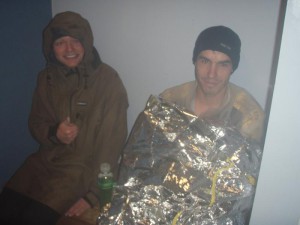
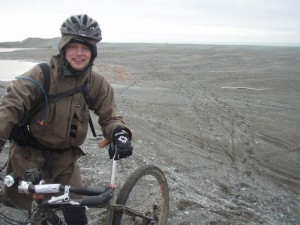
Michi and I were off at 5.30am. Again it was misty, wet and windy. However, ahead lay the flat part of the course, the home straight and everything seemed easy. As we started the long haul out onto Lake Ellesmere Spit, the clouds even began to part and for the first time since we had started the adventure we saw wisps of blue sky. By the time we had pushed our bikes over the lake-ocean outlet, arguably the most unpopular part of the course, the sun was actually out. The southerly is still in force though and eager to make use of it I stomp out the miles back to Christchurch along the back roads surrounding Lake Ellesmere. It all seemed too easy until I hit Halswell, the route taking me towards the base of the Port Hills and in one final push I was riding / walking my way to the Summit Road via Kennedy’s Bush. In a normal event I would curse the organiser. However, being the organiser I agreed with the excellent placement of this final obstacle.
I have never descended Rapaki so fast, my wheels floated over the gravel between tyres tracks and I barely touched my brakes as I eagerly approached the finish. The road beckoned, one last intersection, onto the quaint little bridge over the Heathcott River and there it was, Hanson Park, where all this madness started just under 28 hours before. One last detour was required to avoid the Sunday afternoon cricket game and I am done, well and truly done.
28 brave souls started the inaugural Le Petit Brevet, 17 finished. Times ranged from an astonishing 21 hours and 55 minutes clocked up by local speedster Ollie Whalley to a fraction over 36 hours. The plan is to have a new course over the hills and bays of the Banks Peninsula every year. If you’re keen for an early summer challenge over some beautiful touring country next November, check out http://lepetitebrevet.blogspot.com/ and register your interest.
(First published in New Zealand Mountain Biker Magazine – 2011) Photos: John Randal & Tim Mulliner
Footnote: Le Petit Brevet was run for the fifth time in succession in November 2014
